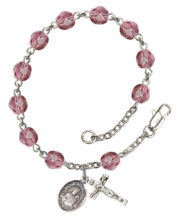Mary
Our Lady of Czestochowa
What is the devotion to Our Lady of Czestochowa
The devotion to Our Lady of Czestochowa, also known as the Black Madonna, is a Marian devotion that centers around the image of the Virgin Mary enshrined in the Pauline Monastery of Jasna Gora, in Czestochowa, Poland. The image is a Byzantine-style icon that depicts Mary holding the baby Jesus, and it is said to be miraculous. The devotion has its roots in the 14th century and has been closely linked to the history and culture of Poland.
The origins of the devotion to Our Lady of Czestochowa are not entirely clear, but it is believed that the icon was brought to Poland in the 14th century by Prince Ladislaus the Short. According to legend, the icon was painted by Saint Luke the Evangelist and was in the possession of Saint Helena, the mother of Emperor Constantine the Great. The icon was then passed down through generations of Eastern Christian monks, finally coming to rest in the Pauline Monastery of Jasna Gora.
The devotion to Our Lady of Czestochowa has been closely linked to the history of Poland. The image has been venerated as a symbol of Polish national identity and has been seen as a protector of the Polish people. The image became particularly significant during the Swedish invasion of Poland in the 17th century, when the Polish soldiers credited the miraculous intervention of Our Lady of Czestochowa with their victory.
The Monastery of Jasna Gora, where the icon is kept, is considered one of the most important pilgrimage sites in Poland and is visited by thousands of people each year. The devotion to Our Lady of Czestochowa is also closely tied to the Polish Orthodox Church and is considered one of the most important shrines in the Orthodox Church in Poland.
The feast of Our Lady of Czestochowa is celebrated on August 26th and is considered a major feast day in Poland. The feast day is celebrated with a special mass and a procession in which the icon is taken from the Monastery of Jasna Gora and carried through the streets of Czestochowa.
The icon of Our Lady of Czestochowa is also known as the Black Madonna because of the dark discolorations that have formed on the surface of the image over time. These discolorations are believed to have been caused by the smoke of candles that were lit in front of the image over the centuries. The Black Madonna has become a symbol of the suffering of the Polish people and is often associated with the idea of Polish martyrology.
Devotion to Our Lady of Czestochowa is not limited to Poland, but is also shared by Polish diaspora communities around the world. It has been an important part of Polish culture and has played a significant role in the preservation of Polish identity and culture.
The devotion to Our Lady of Czestochowa, also known as the Black Madonna, is a Marian devotion that centers around the image of the Virgin Mary enshrined in the Pauline Monastery of Jasna Gora, in Czestochowa, Poland. The image is believed to be painted by Saint Luke and brought to Poland in the 14th century by Prince Ladislaus the Short. It has been closely linked to the history and culture of Poland, seen as a symbol of Polish national identity and protection of the Polish people. Monastery of Jasna Gora, where the icon is kept, is considered one of the most important pilgrimage sites in Poland.
Feast Day of Our Lady of Czestochowa
The Feast Day of Our Lady of Czestochowa, also known as the Feast of the Black Madonna, is celebrated on August 26th. It is a major feast day in Poland and is also celebrated by many Catholics around the world.
The celebration of the Feast Day of Our Lady of Czestochowa typically includes a Mass and procession in honor of the Virgin Mary. Many Catholics will attend a special Mass in the morning and then participate in a procession to the Jasna Góra Monastery in Czestochowa, Poland, where the image of Our Lady of Czestochowa is kept and venerated. The monastery is often decorated with flowers, candles, and other decorations for the feast day, and many people will leave offerings of flowers or candles in front of the image.
In addition to the religious celebrations, there are also many cultural celebrations that take place around the Feast Day of Our Lady of Czestochowa. This includes traditional dances, parades, and other performances. People also make traditional foods such as Pierogi, bigos and kutia.
Some Catholics may also celebrate the feast day by praying the rosary, reading passages from the Bible or other religious texts, or by participating in other devotions or spiritual practices.
Additionally, it’s worth mentioning that Our Lady of Czestochowa is the patron saint of Poland and her feast is a national holiday in this country.


